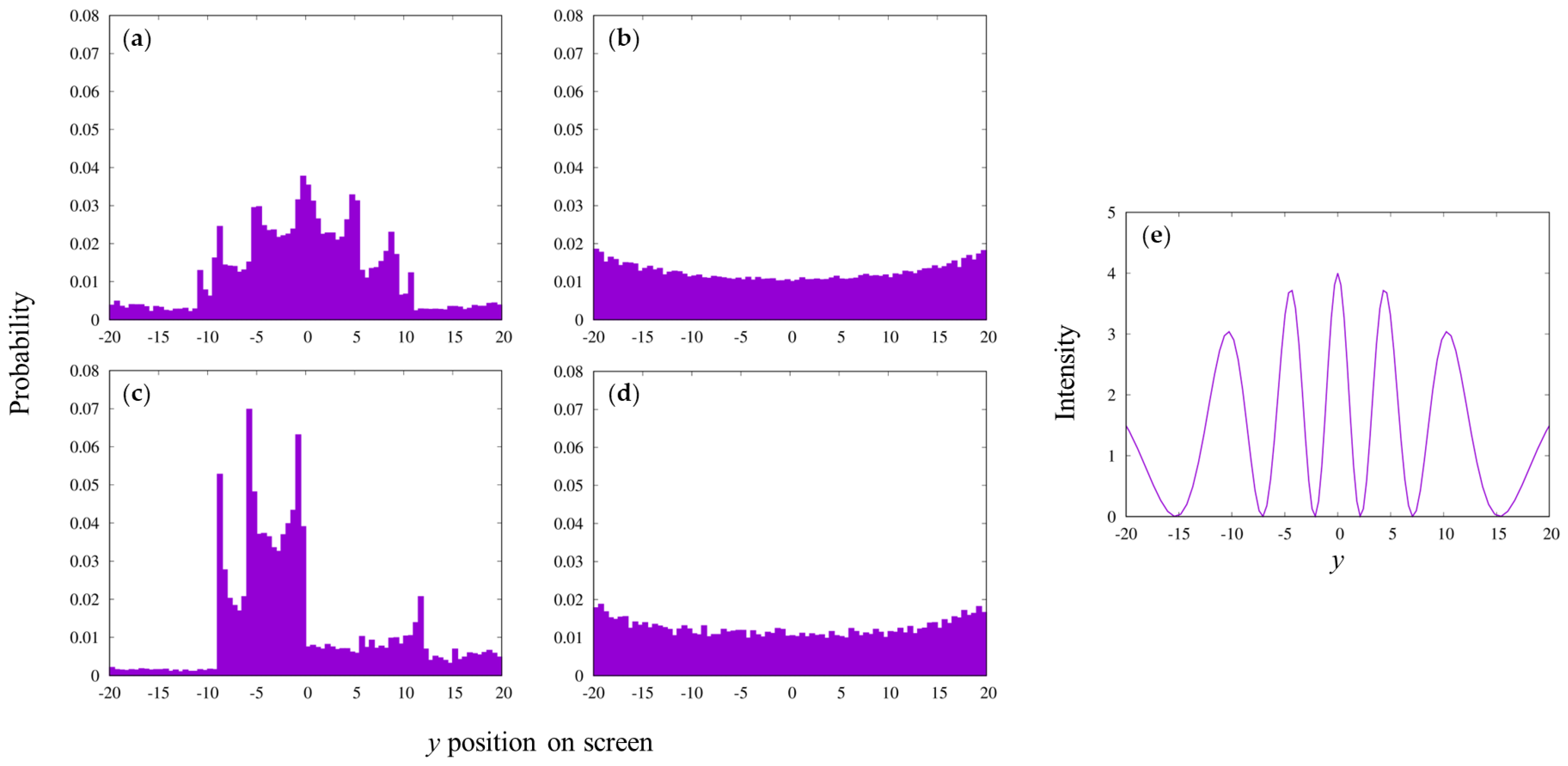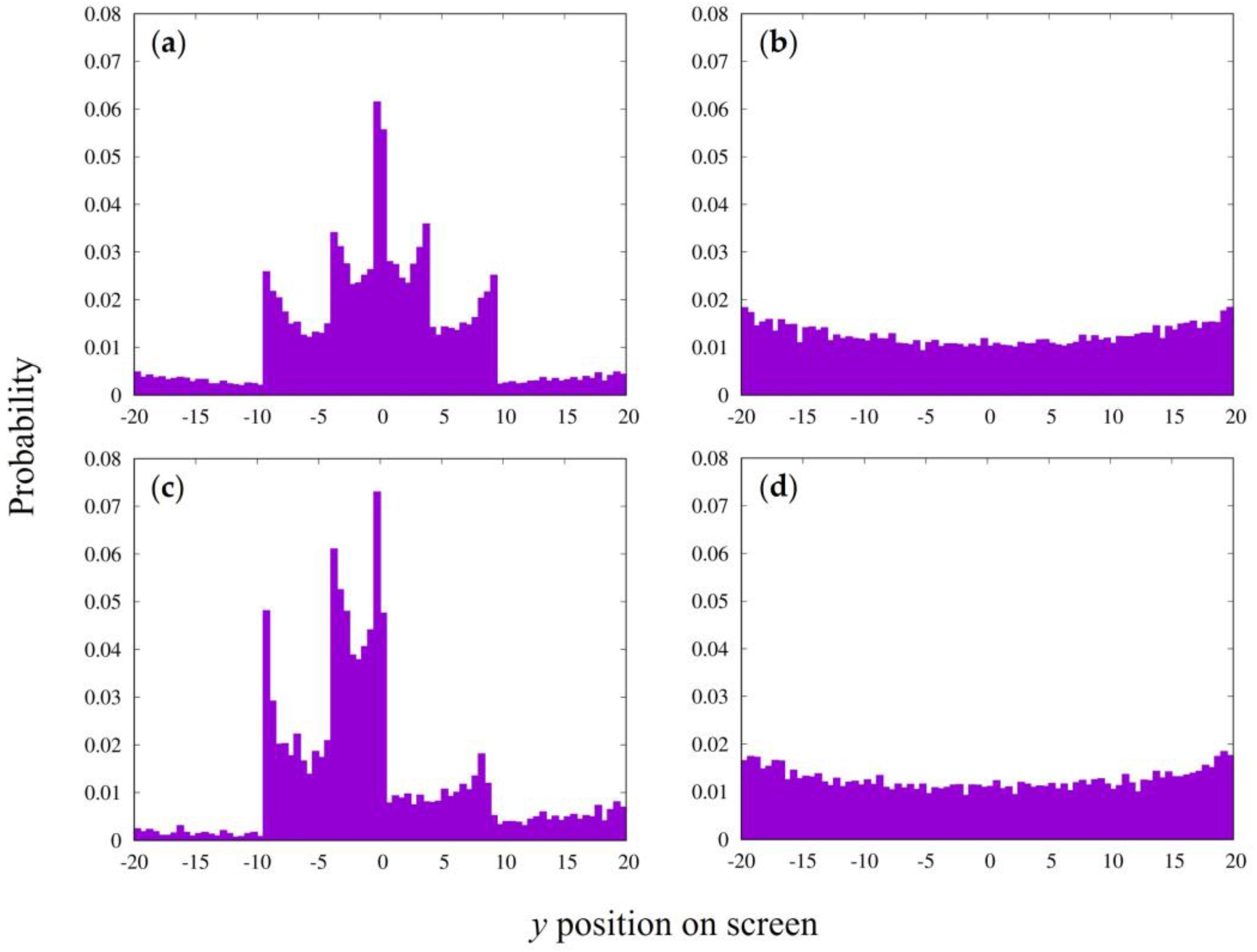Adaptive Dynamics Simulation of Interference Phenomenon for Physical and Biological Systems
Abstract
:1. Introduction
2. Methods
3. Results
3.1. In Case of Parallel Emission of a Particle
3.2. In the Case of Point Emission of a Particle
4. Discussion
Author Contributions
Funding
Institutional Review Board Statement
Data Availability Statement
Conflicts of Interest
References
- Ohya, M. Adaptive dynamics and its applications to chaos and NPC problem. In Quantum Bio-Informatics: From Quantum Information to Bio-Informatics; Accardi, L., Freudenberg, W., Ohya, M., Eds.; World Scientific: Singapore, 2008; pp. 181–216. [Google Scholar]
- Asano, M.; Khrennikov, A.; Ohya, M.; Tanaka, Y.; Yamato, I. Quantum Adaptivity in Biology: From Genetics to Cognition; Springer: Dordrecht, The Netherlands, 2015; pp. 1–173. [Google Scholar]
- Asano, M.; Khrennikov, A.; Ohya, M.; Tanaka, Y.; Yamato, I. Three body system metaphor for two slit experiment and Escherichia coli lactose-glucose metabolism. Philos. Trans. R. Soc. A 2016, 374, 20150243. [Google Scholar] [CrossRef] [PubMed]
- Bohr, N. Atomic Theory and Description of Nature; Cambridge University Press: Cambridge, UK, 1934. [Google Scholar]
- Einstein, A.; Podolsky, B.; Rosen, N. Can quantum-mechanical description of physical reality be considered complete? Phys. Rev. 1935, 47, 777–780. [Google Scholar] [CrossRef]
- Feynman, R.P. The concept of probability in quantum mechanics. In Proceedings of the 2nd Berkeley Symposium on Mathematical Statistics and Probability, Los Angeles, CA, USA, 31 July–12 August 1950; University of California Press: Berkeley, LA, USA, 1951; pp. 533–541. [Google Scholar]
- Accardi, L.; Khrennikov, A.; Ohya, M. Quantum Markov model for data from Shafir-Tversky experiments in cognitive psychology. Open Syst. Inf. Dyn. 2009, 16, 371–385. [Google Scholar] [CrossRef]
- Aerts, D.; Gabora, L.; Sozzo, S. Concepts and their dynamics: A quantum-theoretic modeling of human thought. Top. Cogn. Sci. 2013, 5, 737–772. [Google Scholar] [CrossRef]
- Asano, M.; Ohya, M.; Tanaka, Y.; Khrennikov, A.; Basieva, I. On application of Gorini-Kossakowski-Sudarshan-Lindblad equation in cognitive psychology. Open Syst. Inf. Dyn. 2011, 18, 55–69. [Google Scholar] [CrossRef]
- Asano, M.; Ohya, M.; Tanaka, Y.; Basieva, I.; Khrennikov, A. Quantum-like model of brain’s functioning: Decision making from decoherence. J. Theor. Biol. 2011, 281, 56–64. [Google Scholar] [CrossRef]
- Asano, M.; Basieva, I.; Khrennikov, A.; Ohya, M.; Tanaka, Y.; Yamato, I. Quantum-like model for the adaptive dynamics of the genetic regulation of E. coli’s metabolism of glucose-lactose. Syst. Synth. Biol. 2012, 6, 1–7. [Google Scholar] [CrossRef]
- Asano, M.; Basieva, I.; Khrennikov, A.; Ohya, M.; Tanaka, Y.; Yamato, I. Towards modeling of epigenetic evolution with the aid of theory of open quantum systems. AIP Conf. Proc. 2012, 1508, 75–85. [Google Scholar]
- Aerts, D.; Sassoli de Bianchi, M.; Sozzo, S.; Veloz, T. Modeling human decision-making: An overview of the Brussels quantum approach. Found. Sci. 2021, 26, 27–54. [Google Scholar] [CrossRef]
- Aerts, D.; Aerts Arguëlles, J.; Beltran, L.; Geriente, S.; Sassoli de Bianchi, M.; Sozzo, S.; Veloz, T. Quantum entanglement in physical and cognitive systems: A conceptual analysis and a general representation. Eur. Phys. J. Plus 2019, 134, 493. [Google Scholar] [CrossRef]
- Heylighen, F. Entanglement, symmetry breaking and collapse: Correspondences between quantum and self-organizing dynamics. Found. Sci. 2023, 28, 85–107. [Google Scholar] [CrossRef]
- Aerts, D.; Aerts, S.; Broekaert, J.; Gabora, L. The violation of Bell inequalities in the macroworld. Found. Phys. 2000, 30, 1387–1414. [Google Scholar] [CrossRef]
- Khrennikov, A. Contextual Approach to Quantum Formalism; Springer: Heidelberg, Germany, 2020. [Google Scholar]
- Castañeda, R.; Matteucci, G.; Capelli, R. Quantum Interference without Wave-Particle Duality. J. Mod. Phys. 2016, 7, 375–389. [Google Scholar] [CrossRef]
- Michielsen, K.; Mohanty, S.; Arnold, L.; De Raedt, H. Event-based simulation of interference with alternatingly blocked particle sources. AIP Conf. Proc. 2012, 1424, 246–250. [Google Scholar]
- De Raedt, H.; Michielsen, K.; Hess, K. The digital computer as a metaphor for the perfect laboratory experiment: Loophole-free Bell experiments. Comput. Phys. Commun. 2016, 209, 42–47. [Google Scholar] [CrossRef]
- De Raedt, H.; Michielsen, K.; Hess, K. Irrelevance of Bell’s Theorem for experiments involving correlations in space and time: A specific loophole-free computer-example. arXiv 2016, arXiv:1605.05237. [Google Scholar]
- De Raedt, H.; Michielsen, K.; Hess, K. The photon identification loophole in EPRB experiments: Computer models with single-wing selection. Open phys. 2017, 15, 713–733. [Google Scholar] [CrossRef]
- Mesa Pascasio, J.; Fussy, S.; Schwabl, H.; Grőssing, G. Classical Simulation of Double Slit Interference via Ballistic Diffusion. J. Phys. Conf. Ser. 2012, 361, 012041. [Google Scholar] [CrossRef]
- Grőssing, G.; Fussy, S.; Mesa Pascasio, J.; Schwabl, H. Elements of sub-quantum thermodynamics: Quantum motion as ballistic diffusion. J. Phys. Conf. Ser. 2011, 306, 012046. [Google Scholar] [CrossRef]
- Grőssing, G.; Fussy, S.; Mesa Pascasio, J.; Schwabl, H. An explanation of interference effects in the double slit experiment: Classical trajectories plus ballistic diffusion caused by zero-point fluctuations. Ann. Phys. 2012, 327, 421–443. [Google Scholar] [CrossRef]
- Alder, B.J.; Wainwright, T.E. Phase transition for a hard sphere system. J. Chem. Phys. 1957, 27, 1208–1209. [Google Scholar] [CrossRef]
- Hecht, E. Optics; Addison-Wesley, Reading: Boston, MA, USA, 2002. [Google Scholar]
- Kim, Y.; Yu, R.; Kulik, S.P.; Shih, Y.; Scully, M. Delayed “Choice” Quantum Eraser. Phys. Rev. Lett. 2000, 84, 1–5. [Google Scholar] [CrossRef] [PubMed]
- Nelson, E. Dynamical Theories of Brownian Motion; Princeton University Press: Princeton, NJ, USA, 1967. [Google Scholar]
- Yamato, I.; Murata, T.; Khrennikov, A. Energy and information flows in biological systems: Bioenergy transduction of V1-ATPase molecular rotary motor and dynamics of thermodynamic entropy in information flows. Prog. Biophys. Mol. Biol. 2017, 130, 33–38. [Google Scholar] [CrossRef] [PubMed]
- Walleczek, J.; Grössing, G. Nonlocal quantum information transfer without superluminal signaling and communication. Found. Phys. 2016, 46, 1208–1228. [Google Scholar] [CrossRef]
- Nagasawa, M. New Quantum Theory According to Markov Process Theory; Shueisha/Sanseido Co., Ltd.: Tokyo, Japan, 2012; pp. 1–305. ISBN 978-4-88142-541-1. (In Japanese) [Google Scholar]





Disclaimer/Publisher’s Note: The statements, opinions and data contained in all publications are solely those of the individual author(s) and contributor(s) and not of MDPI and/or the editor(s). MDPI and/or the editor(s) disclaim responsibility for any injury to people or property resulting from any ideas, methods, instructions or products referred to in the content. |
© 2023 by the authors. Licensee MDPI, Basel, Switzerland. This article is an open access article distributed under the terms and conditions of the Creative Commons Attribution (CC BY) license (https://creativecommons.org/licenses/by/4.0/).
Share and Cite
Ando, T.; Asano, M.; Khrennikov, A.; Matsuoka, T.; Yamato, I. Adaptive Dynamics Simulation of Interference Phenomenon for Physical and Biological Systems. Entropy 2023, 25, 1487. https://doi.org/10.3390/e25111487
Ando T, Asano M, Khrennikov A, Matsuoka T, Yamato I. Adaptive Dynamics Simulation of Interference Phenomenon for Physical and Biological Systems. Entropy. 2023; 25(11):1487. https://doi.org/10.3390/e25111487
Chicago/Turabian StyleAndo, Tadashi, Masanari Asano, Andrei Khrennikov, Takashi Matsuoka, and Ichiro Yamato. 2023. "Adaptive Dynamics Simulation of Interference Phenomenon for Physical and Biological Systems" Entropy 25, no. 11: 1487. https://doi.org/10.3390/e25111487
APA StyleAndo, T., Asano, M., Khrennikov, A., Matsuoka, T., & Yamato, I. (2023). Adaptive Dynamics Simulation of Interference Phenomenon for Physical and Biological Systems. Entropy, 25(11), 1487. https://doi.org/10.3390/e25111487





